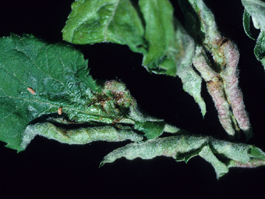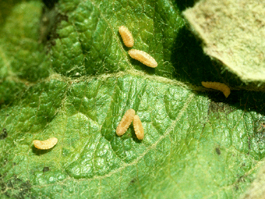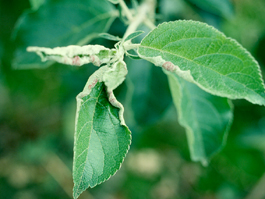by Eric LaGasa, published online December 2007; revised 2017 by Elizabeth H. Beers
Dasineura mali (Kieffer) (Diptera: Cecidomyiidae)

The apple leaf midge (also known as apple leaf curling midge and apple leaf gall midge) is an exotic foliar pest of apple trees first reported in Washington State from a commercial apple orchard in Northern Whatcom County in July, 1994, although it may have been present as early as 1991.
Current distribution in the Canada includes Frasier River Delta and the Okanagan Valley.
In Washington, it has been detected west of the Cascades in Whatcom and Skagit Counties and east of the Cascades in Okanogan county (just south of the Canadian border) and in the Othello region of the Columbia Basin.
European in origin, the pest also occurs in New Zealand, (first recorded in 1916) and Eastern U. S. and Canada (first recorded from New Brunswick in 1964). Apple leaf midge is generally not considered an economic pest of mature apple trees. However, high populations in nurseries or on young trees or top-worked (grafted) stock may stunt growth or kill terminal shoots.
Hosts
All varieties of apple (Malus spp.)
Life Stages

Egg
Eggs are laid singly in the leaf folds or along the margins of developing leaves.
Larva
Larvae are tiny legless maggots, initially pale-yellow but becoming reddish-orange as they develop inside rolled leaves (galls). Full grown they are 1.5 to 2.5 mm long.
Pupa
Pupae are segmented, light-orange capsules, inside silk cocoons, usually in the soil directly under the infested trees.
Adult
Adults are very small dark (black) flies, 2 or 3 mm in length, with clear wings. Smaller than mosquitoes, they are easily overlooked when sitting on leaves or flying around apple trees during mating or egg laying.
Life history
The biology and developmental timing are not well documented in the Pacific Northwest. Apple leaf midge overwinters as pupae in the soil under infested trees. First generation adults emerge in May, and after mating, the adult females deposit eggs on developing leaves. After larvae complete development inside tightly curled leaves, some may pupate in the rolled leaves but most drop to the ground to pupate in leaf litter or just below the soil surface. Pupae are surrounded by tough, silken cocoons. In the Northwest, two or three generations are produced each season, although suspected overlapping of generations has been reported and timing of generations has been little studied. In Europe, lack of rain is reported to delay larvae from leaving hardened leaves to pupate , which can prolong development time.
Damage
Midge larvae feed along the margins of developing leaves, causing leaves to develop gall-like thickening and tight, inward curling. The infested leaves roll into distorted tubes, may discolor (reddish), become brown and brittle, finally dropping from the tree. Terminal shoots may be stunted as a result, and grafted scions have been reported as seriously retarded, or in some cases, killed.
Monitoring

Leaf damage (rolled and discolored leaf galling) can be detected by visual examination, and suspected infestation can be confirmed by the presence of yellowish or orangish larvae inside leaf rolls. Adult emergence may be monitored in the spring with simple emergence cages placed on soil under infested trees.
Biological control
Minute pirate bugs, Orius spp. and other bugs have been observed feeding on apple leaf midge larvae in our area. In Eastern Canada, the introduced European parasitoid Platygaster demades has been shown to effectively reduce (40-90%) the first generation leaf curling midges. This parasitoid is beeing considered for importation into the Pacific Northwest.
Management
Control of apple leaf midge is difficult using insecticides since the larvae are well protected inside the curled up leaves. At this time, no products are registered to control this pest in the Pacific Northwest. However, broad spectrum products applied to manage other insect pests in the orchard may also be efficacious against apple leaf midge larvae.
References consulted
Alford, D. V., 1984, “A Colour Atlas of Fruit Pests their recognition, biology, and control”, Wolf Publishing, London, England.
Antonelli, Art, PLS 18 “Apple Leaf Curling Midge”, October 2005, WSU Puyallup (and personal communication).
Cossentine, Joan, Research Scientist, Summerland Agri-Food Research Centre / Agriculture and Agri-Food Canada (personal communication)
Phillip, Hugh, Entomologist, B.C. Ministry of Lands and Agriculture, Kelowna (personal communication).
